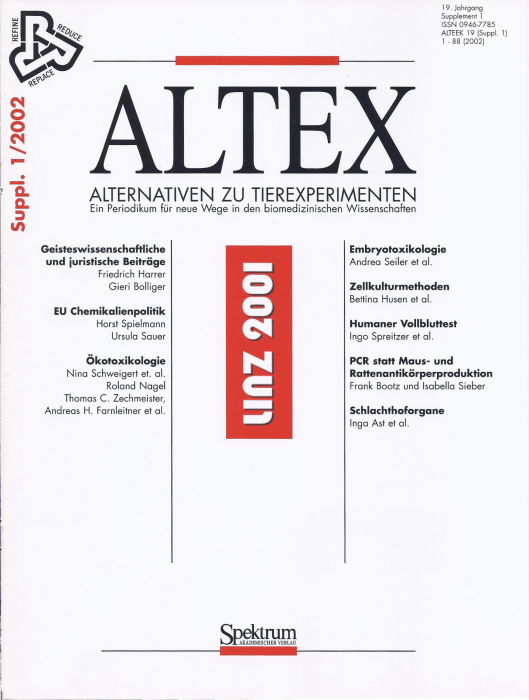[Improving the embryonic stem cell test (EST) by establishing molecular endpoints of tissue specific development using murine embryonic stem cells (D3 cells)] [Article in German]
Main Article Content
Abstract
Blastocyst-derived pluripotent embryonic stem (ES) cells of the mouse can be induced to differentiate in culture into a variety of cell types, including cardiac muscle cells. In the embryonic stem cell test (EST) the capacity of ES cells of the mouse cell line D3 to differentiate into contracting cardiomyocytes is used to assess the embryotoxic potential of test compounds and in addition, the effects on the viability of ES cells and differentiated mouse fibroblasts (cell line 3T3) are compared. The three endpoints are used to classify the embryotoxic potential of chemicals after 10 days of exposure: (i) the inhibition of differentiation of ES cells into cardiomyocytes (ID50) and (ii) the decrease of viability of 3T3 cells (IC503T3) and (iii) ES cells (IC50D3) in a MTT cytotoxicity test. Applying linear analysis of discriminance, a biostatistical prediction model (PM) was developed to assign test chemicals to three classes of embryotoxicity. In an international validation study funded by ECVAM it could be demonstrated that the EST can predict the embryotoxic potential of a test compound as good as frequently used mammalian systems based on pregnant animals. In a joint project with major German pharmaceutical companies we are attempting to improve the EST by establishing molecular endpoints of differentiation (e.g. cardiac, neuronal, chondrogenic) in cultured ES cells. We have studied the expression of tissue specific proteins in ES cell cultures in the presence of embryotoxic chemicals by immunofluorescent antibody techniques, e.g. FACS analysis. The other groups are focusing on endogenous gene expression in early development by RT-PCR methods or the DNA microarray technique. The results obtained recently using molecular markers specific for cardiac differentiation and employing intracellular flow cytometry for quantification will be presented. Molecular endpoints will allow improvement of the EST by measuring gene expression patterns in a small number of murine ES cells.
Article Details

This work is licensed under a Creative Commons Attribution 4.0 International License.
Articles are distributed under the terms of the Creative Commons Attribution 4.0 International license (http://creativecommons.org/licenses/by/4.0/), which permits unrestricted use, distribution and reproduction in any medium, provided the original work is appropriately cited (CC-BY). Copyright on any article in ALTEX is retained by the author(s).


